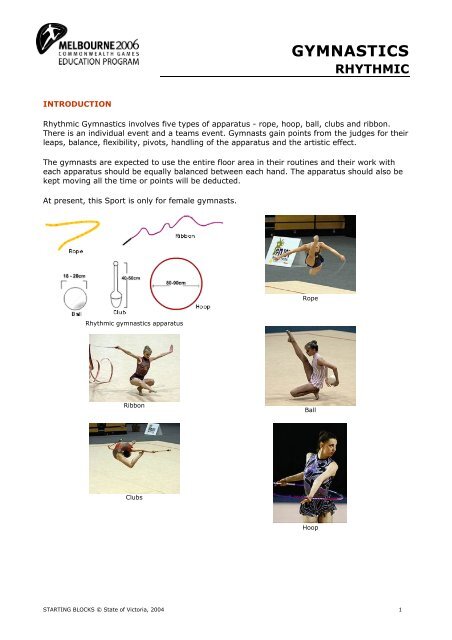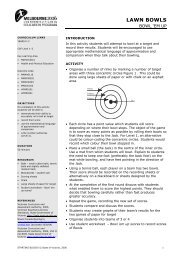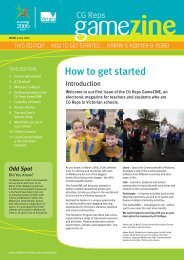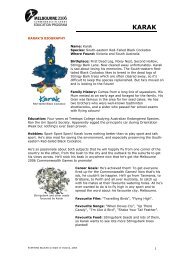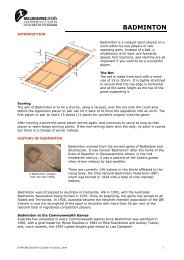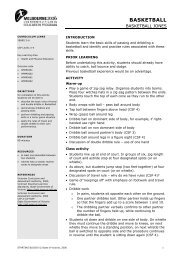gymnastics rhythmic - Education Program
gymnastics rhythmic - Education Program
gymnastics rhythmic - Education Program
You also want an ePaper? Increase the reach of your titles
YUMPU automatically turns print PDFs into web optimized ePapers that Google loves.
GYMNASTICS<br />
RHYTHMIC<br />
INTRODUCTION<br />
Rhythmic Gymnastics involves five types of apparatus - rope, hoop, ball, clubs and ribbon.<br />
There is an individual event and a teams event. Gymnasts gain points from the judges for their<br />
leaps, balance, flexibility, pivots, handling of the apparatus and the artistic effect.<br />
The gymnasts are expected to use the entire floor area in their routines and their work with<br />
each apparatus should be equally balanced between each hand. The apparatus should also be<br />
kept moving all the time or points will be deducted.<br />
At present, this Sport is only for female gymnasts.<br />
Rope<br />
Rhythmic <strong>gymnastics</strong> apparatus<br />
Ribbon<br />
Ball<br />
Clubs<br />
Hoop<br />
STARTING BLOCKS © State of Victoria, 2004 1
HISTORY OF RHYTHMIC GYMNASTICS<br />
GYMNASTICS<br />
RHYTHMIC<br />
The appearance of Rhythmic Gymnastics dates to the end of<br />
the nineteenth century, through ideas that developed on the<br />
expression of movement and the development of rhythm. As a<br />
competitive discipline, Rhythmic Gymnastics began in the<br />
former Soviet Union in the 1940s.<br />
Performing with the hoop<br />
The International Gymnastics Federation (FIG) recognised the<br />
new discipline in 1961, while the first World Championship for<br />
individual contestants was staged in Budapest in 1963.<br />
The group events were introduced in the competition schedule in 1967, at the World<br />
Championships held in Copenhagen.<br />
Rhythmic Gymnastics was introduced as an official Olympic discipline in the 1984 Los Angeles<br />
Olympic Games program, while the first group competition was introduced twelve years later,<br />
in 1996, at the Atlanta Olympic Games.<br />
Rhythmic Gymnastics at the Commonwealth Games<br />
Rhythmic Gymnastics first appeared at the Commonwealth Games in 1990 in Auckland, New<br />
Zealand. At the 1994 Games in Vancouver, Canada, Australian Kasumi Takahashi won all five<br />
individual gold medals in Rhythmic Gymnastics.<br />
ABOUT RHYTHMIC GYMNASTICS<br />
Rhythmic gymnasts compete on a floor area of 13m square. A<br />
balanced composition is achieved between the gymnast, the<br />
apparatus and the music, plus required difficulties. The<br />
apparatus must be used in both hands, thrown into the air<br />
and kept in constant motion. Rhythmic gymnasts also<br />
compete in levels 1–10 or in an international stream.<br />
There are five apparatus in Rhythmic Gymnastics:<br />
Performing with the ball<br />
o Balls o Club<br />
o Hoop o Ribbon<br />
o Rope<br />
Ball<br />
The ball must rest in the gymnast's hand and not against the<br />
wrist. The elements include rolling, throwing and bouncing.<br />
The gymnast must use both hands while showing continuous<br />
flowing movement over the whole floor area.<br />
Performing with the ball<br />
STARTING BLOCKS © State of Victoria, 2004 2
GYMNASTICS<br />
RHYTHMIC<br />
Hoop<br />
Fundamental elements include rotation around the body or<br />
hand and rolling. Other elements include swings, circles,<br />
figures of eight, throws, passes through and over the hoop.<br />
Performing with the hoop<br />
Rope<br />
Requirements include leaps over the rope and skipping, as<br />
well as swings, throws, circles, rotations and figures of eight.<br />
Performing with the rope<br />
Clubs<br />
Characterised by <strong>rhythmic</strong>al tapping, the clubs are made of<br />
wood or synthetic material. Fundamental elements include<br />
mills and small circles, with other elements such as swings,<br />
circles, asymmetric movements, throwing and catching. The<br />
clubs must be used in both hands and one hand.<br />
Performing with clubs<br />
Ribbon<br />
The ribbon is used for large, smooth and flowing movements.<br />
Fundamental elements include swings, circles, 'serpents' and<br />
spirals. It requires a high degree of coordination to form the<br />
spiral as any knots that accidentally form in the ribbon are<br />
penalised.<br />
Performing the spiral<br />
with the ribbon<br />
STARTING BLOCKS © State of Victoria, 2004 3
RHYTHMIC GYMNASTICS EQUIPMENT<br />
GYMNASTICS<br />
RHYTHMIC<br />
Rhythmic gymnasts compete on a floor area of 13 metres<br />
square. A balanced composition is achieved with a balance<br />
between the gymnast, the apparatus and the music plus<br />
required difficulties.<br />
Performing with the clubs<br />
The apparatus must be used in both hands, thrown into the air<br />
and kept in constant motion. Rhythmic gymnasts also compete<br />
in levels 1-10 or in an international stream.<br />
There are five apparatus in Rhythmic Gymnastics:<br />
Ball<br />
Made of rubber or synthetic material<br />
and 18–20cm in diameter.<br />
Hoop<br />
The hoop is made of<br />
plastic or wood and is 80–<br />
90cm in diameter.<br />
Rope<br />
A light and supple rope<br />
usually made of hemp or<br />
synthetic material.<br />
Clubs<br />
Characterised by <strong>rhythmic</strong>al<br />
tapping, the clubs are made of wood<br />
or synthetic material.<br />
Ribbon<br />
The ribbon is 6m in<br />
length, used for large,<br />
smooth and flowing<br />
movements.<br />
STARTING BLOCKS © State of Victoria, 2004 4
GYMNASTICS<br />
RHYTHMIC<br />
RHYTHMIC GYMNASTICS – EVENT INFORMATION<br />
Gymnastics will be a combination of two disciplines; Artistic<br />
and Rhythmic.<br />
It is proposed that both the Artistic Gymnastic and Rhythmic<br />
Gymnastic disciplines will be staged in a purpose built facility<br />
at the Melbourne Exhibition Centre (MEC).<br />
Events<br />
Event Male Female Team<br />
Rhythmic<br />
The MEC was also be the competition venue for the 2003<br />
World Gymnastics Championships.<br />
It is proposed that a warm-up facility be constructed in an air<br />
conditioned hall adjoining the competition venue.<br />
This facility would contain two full sets of equipment and be available for training at least<br />
seven days prior to and during the event.<br />
It is proposed that both the Artistic Gymnastics and Rhythmic Gymnastic disciplines will be<br />
conducted on an internationally accredited, purpose built, demountable podium within MEC.<br />
Its capacity of 7 500 is considered necessary given the popularity of Gymnastics at the<br />
Commonwealth Games. All equipment utilised for this event will be of the highest international<br />
standard.<br />
RHYTHMIC GYMNASTICS - DID YOU KNOW?<br />
Only women compete in Rhythmic Gymnastics.<br />
There are five Rhythmic Gymnastics events – ball, hoop, rope, club and ribbon.<br />
The ribbon is 6m in length and must be continually moving throughout the performance.<br />
STARTING BLOCKS © State of Victoria, 2004 5
GYMNASTICS<br />
RHYTHMIC<br />
JOIN IN RHYTHMIC GYMNASTICS<br />
Junior <strong>Program</strong>s<br />
Gymnastics has developed two school programs:<br />
Gymnastics Victoria logo<br />
o AEROskools – a sport aerobic participation program<br />
delivered within schools by teachers or qualified<br />
fitness instructors.<br />
o GYMskools – a program which is delivered by<br />
Kidskills Australia. It involves holding gym lessons<br />
that will enhance and support you school PE<br />
curriculum.<br />
To find out more about Gymnastics and where to take part, please contact:<br />
Gymnastics Victoria - www.<strong>gymnastics</strong>victoria.org.au<br />
Phone: (03) 92146020<br />
Gymnastics Australia - www.<strong>gymnastics</strong>.org.au<br />
Phone: (03) 98304588<br />
STARTING BLOCKS © State of Victoria, 2004 6


